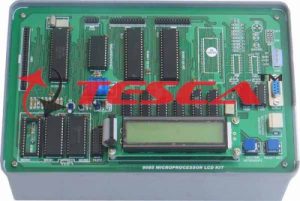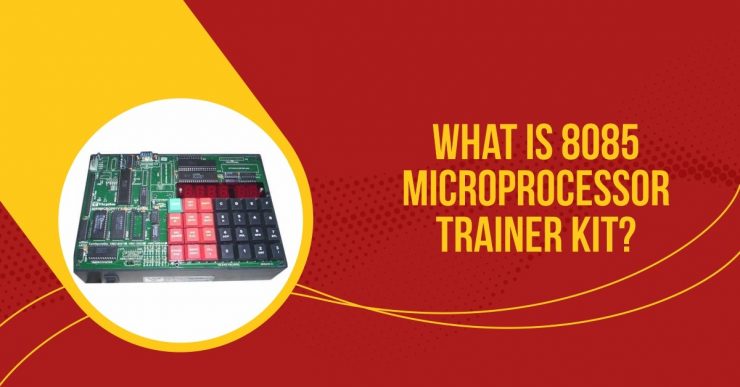Table of Contents
What is the 8085 Microprocessor Kit?
It was first designed in the year 1977 by Intel. 8085 is an 8-bit modified form of a microprocessor. It processes the binary data as per the instruction stored in memory and gives a suitable outcome.
One can find its applications in ovens, gadgets, washing machines, and various other devices. The microprocessor kit is a single-board computer that helps in practicing 8085 microprocessors.
The kit costs quite little and is good for the learning process. It allows one to start from a low-level language and gradually reach high-level programming.
History of Microprocessor:

The first-ever microprocessor was designed in the year 1971 by Intel. It was a 4-bit processor and thus named 4004 Intel. Later Intel was succeeded in designing 8080 microprocessors for PC in 1974.
And then came 8085, the modified version of the 8080 microprocessor. It was completely similar to 8080 but with advanced programming capacity and some adjustments. It is an 8-bit processor.
1976 was the year for 8086 microprocessors. This 16-bit processor is much better than others. All the processors yet discovered were not supportive of floating numbers, that is, decimal numbers. So, to solve this problem, Intel discovered an 8087 processor.
It was rooted in IBM PC and was the first math co-processor. After that, efforts were constantly made to help the company develop other microprocessors like Pentium II, 8088, 80286, Core 2Duo, etc.
Want to know more about 8085 Microprocessor Trainer? Watch our video:
Classification of Microprocessors:
The microprocessor is classified into the following three categories:
1. RISC Processor:
Reduced Instruction Set Computer (RISC) simplifies the instruction set and reduces the time of execution. By RISC, every set only needs one clock cycle for execution. Hence, the efficiency gets reduced, and that leads to the requirement of more RAM.
2. CISC Processor:
Complex instruction set computer (CISC) reduces the number of instructions of each program. It does not take into consideration the number of cycles per program. It builds the complex operations into hardware directly. It requires every little RAM due to the shorter length of code. Thus, the compiler easily translates high-level language to assembly language.
3. Special Processor:
These processors perform special functions. These special microprocessors include co-processor, input/output processor, transputer, DSP, and many more. They all have their functions.
Features of 8085 Microprocessor:
The features of the 8085 microprocessors are:
- An 8-bit microprocessor to do the operation and generate 8-bit information
- 16-bit address and 8-bit data line that makes the capacity of the microprocessor as 64KB.
- Single NMOS chip and 6200 transistors
- 246 codes and 80 instructions
- 256 input and output ports
- DIP of 40 pins
- Shares bus with DMA controller
- Internal clock generator
- The duty cycle of 50%
Functional Components of 8085 Microprocessor:
The 8085 microprocessors consist of the following parts, and their functions are:
1. Accumulator:
The accumulator is a register of 8-bit. It functions to achieve arithmetic, logical, I/O, and LOAD/STORE operations. This component in the device is further connected to the data bus and ALU.
2. Arithmetic and Logic Unit:
This is used in performing arithmetic and logical operations. In addition, Subtraction, AND, OR, and some of the other operations are performed on 8-bit data.
3. General-Purpose Register:
B, C, D, E, H, and L are the six general-purpose registers that one can find in 8085 microprocessors. They all can contain 8-bit data. When combined in pairs, these registers can contain 16-bit data. The pairing is of form B-C, D-E, and H-L.
4. Program Counter:
The memory address location of the next executed instruction is stored with the help of a 16-bit program counter. Whenever an instruction is executed, the microprocessor increments the program. Hence, this counterpoints to the address of succeeding instruction.
5. Stack Pointer:
Stack Pointer is a 16-bit register and works just like a stack. During push or pop operations, it gets incremented or decremented by 2.
6. Temporary Register:
As the name suggests, it contains the temporary data of any arithmetic and logical operation. It is also an 8-bit register.
7. Flag Register:
The flag register is an 8-bit. It consists of five 1-bit flip-flops. They all contain either 0 or 1 based on the outcome. The five flip-flops are the sign, zero, auxiliary carry, parity, carry.
When the result is 1, the sign flag gets arranges. On the zero outcomes, the zero flags will be set. In case the result is not zero, then the zero flags will not be set.
8. Instruction Register and Decoder:
The instruction registers and decoder works together. It is an 8-bit register. The instruction register stores the information obtained from memory. After that, the instruction decoder decodes all the information stored by the instruction register.
9. Timing and Control Unit:
The timing and control unit work together to provide control signals for communication in the microprocessor. This unit controls both the internal and external circuits. It helps in performing all the functions.
10. Interrupt Control:
A microprocessor has five interrupt signals: INTR, RST 7.5, RST 6.5, RST 5.5, TRAP. During the process, whenever an interrupt happens, it controls them. It helps the microprocessor to shift all the control in processing the interrupt on completion of the request, the control shifts back to the main program.
11. Serial Input/ Output Control:
Serial Input Signal: It is an input data line signal. When RIM functions are achieved, the information on this line is taken in the 7th bit of the ACC.
Serial Output Signal- It is an output data line signal. When the SIM function is achieved, the information on this line is taken on the 7th bit.
12. Address Buffer and Address-Data Buffer:
The information stored in the stack pointer and program counter needs some way to communicate with the CPU. For this purpose, this information gets loaded into the address buffer and address-data buffer. The connection with CPU and I/O helps in exchanging the wanted data easily.
13. Address Bus and Data Bus:
The data bus helps in carrying the information that needs to be stockpiled. It is bidirectional. The address bus is unidirectional and the location where the information needs to be stored. It helps in transferring data and address I/O devices.
Applications of 8085 Microprocessor Kit?
The development of microprocessors has made the work and performance of many sectors better and easier. The 8085 microprocessors are highly used in many domains for cost-effectiveness, low power consumption, lightweight, and special functions.
8085 microprocessor comes with a set of multiple instructions like Add, Sub, Move, and others. This instructional set gets included in a programming language to perform various operations. This microprocessor can perform even complicated operations.
1. Engineering Applications:
The engineering of many devices and types of equipment is somehow dependent on the use of an 8085 microprocessor. The management devices, protection system, few systems with automatic exit and entry, lifts, and huge machinery are all based on the microprocessor’s working.
2. Medical Usage:
In the insulin pump, the microprocessor is effectively used for regulating it. 8085 microprocessor performs various functions. Its most significant work is storing calculation, processing the information that biosensors send, and scrutinizing the overall outcome.
3. Communication:
In the communication domain, one can find the most extensive and effective benefits of the 8085 microprocessor. It is used in the complete digital telephonic system from the modem, cables to the telephone exchange.
Satellite system like TV also uses the microprocessor. Other than that, the airline registration and that of the railway also use the operation of a microprocessor—the LAN and WAN help to generate communication of data across the different computer systems. It is due to these microprocessors that telecommunicating has become possible.
4. Electronics:
As we all know, the CPU is the computer’s brain, and these CPUs are embedded with the microprocessor to perform all the operations. Microcomputers, personal computers, and supercomputers are all implemented with the microprocessor.
The video games and PC games have all their instructions and programing designed by these microprocessors. The mobiles, iPad, television, radio too uses the applications of the microprocessor for their functioning.
Advantages and Disadvantages of Microprocessors:
The microprocessors are used in almost every other device and domain. All the industries are dependent on the usage of microprocessors. It is due to their effectiveness and performance. But at the same time, there are some limitations of the microprocessor that still needs to be mended.
Advantages:
- The microprocessor is used in all electronic devices to perform operations from basic to complicated ones.
- Its speed is found to be measured in hertz, and hence it can perform a large number of tasks within no time.
- It helps the device move the data from one memory location to another in just a blink of an eye.
Disadvantages:
- Its size data puts a restriction on its use.
- This microprocessor does not support floating numbers that is, decimal operations
- The microprocessor gets overheated, which can damage the device
- It is important to make sure that the microprocessor should not get in contact with other external devices
- The RAM, ROM ad other I/O devices are missing in microprocessors.




